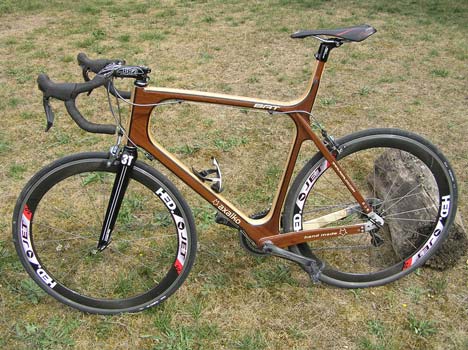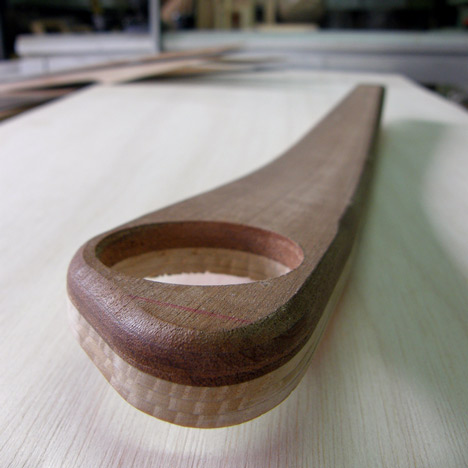BAT bicycle by Axalko
Dezeen promotion: this video shows Basque woodworking company Axalko crafting a bicycle frame from wood.

Enrique Ardura and brothers Aitzol and Andoitz Tellería are carpenters who chose to develop the bicycle to showcase their expertise in thermal wood modification.

They spent two years developing a frame that makes the most of the strength of wood, combining an ash core with a micro-laminated finish that optimises its rigidity and resistance.

A hollow structure reduces the weight, resulting in a lightweight bicycle that is as strong as aluminium or steel.

The frame is handmade and can be customised to match the client's choice of colour or laminated finish.

The project is supported by the Spanish Confederation of Wood, Confemadera and there are more videos about wood craftsmen working in Spain available on Vimeo.

You can see a previous story about Spanish designers working in wood here and all of our stories about bicycles here.
The following text is from Confemadera:
Two Basque carpenters develop an advanced wood bicycle frame that optimizes both resistance and weight
Bilbao (Spain), April 2012 – Six years ago the Tellería brothers (Aitzol and Andoitz), both professionals in the wood industry and fans of bicycle culture and mountain sport, joined up with fellow professional Enrique Ardura. Together, they were inspired to develop a project that combined their knowledge of wood modification technology and all its potential.

Working from their joinery called Txirbil (meaning ‘wood shaving’ in Euskera, the ancient language of the Basque lands), the design team came to the conclusion that the tubular fibers of wood were perfect for creating a fast, sturdy bicycle frame. As well as having an interesting natural aesthetic, wood is resistant, can absorb a high level of vibration and can result much lighter than generally perceived.

Axalko is the name given to these new wooden bicycles, inspired by a character from the brothers’ childhood – a quick and ingenious fox who appeared in fables their grandmother told them.

An in-depth study was called for, looking at the effect the various forces would have on the bike frame in motion. Its micro-laminated finish allows for the utmost levels of resistance and rigidity. On the other hand, its hollow structure makes it really lightweight.
The core of the frame is made with ash tree wood, a species indigenous to the region and that can also be found all over Europe, including the Britain and Ireland. The bike has been favorably tested by members of professional teams as well as in two demanding races in France - the París-Roubaix and the Flandes Tour.

Like if it were a luthier atelier, most of the Axalko bike’s manufacturing process is done by hand, meaning care is taken over every detail, whether technical or aesthetic. Clients can have their model customized by choosing the colors and laminated finish. Durable, practical and elegant, the Axalko bike sets the bar high for stylish commuting.
When asked about their innovative technique, Axalko’s creators simply answer that they have bridled a technology already found in nature.

Mechanical Properties
Average density - 670 kg/m3
Static bending strength - 1140 kg/cm2
Compressive strength - 520 kg/cm2
Tensile strength - 1400 kg/cm2
Elastic modulus - 130000kg/cm2
It is widely believed that wood is one of most sustainable materials because it is natural, renewable, recyclable, biodegradable, non-toxic and only requires low, CO2-free energy to be transformed.

Additionally, these two elements found in wood provide a magnificent weight- strength ratio:
− Lignin makes the cell walls rigid with a compressive strength of 2,400 kg/cm2, which is higher than the concrete.
− Cellulose fibers held together by a lignin binder have a tensile strength of 10,000 kg/cm2, which is superior to steel.
Content promoted by Confemadera
Sponsored by Spanish Institute of Foreign Trade (ICEX) and EU European Regional Development Fund